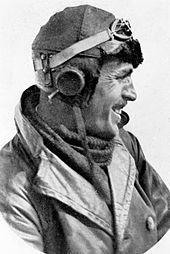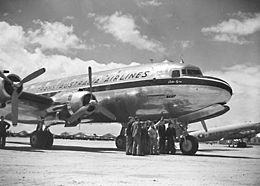Lester Brain
Lester Joseph Brain | |
|---|---|
King's Commendation | |
| Aviation career | |
| Air force | Royal Australian Air Force |
| Battles | World War II |
| Rank | Wing Commander |
Lester Joseph Brain,
Seeing little prospect for advancement at Qantas once the war had ended, Brain left to join the fledgling government-owned domestic carrier
Pre-war career
Early life
Born in Forbes, New South Wales, on 27 February 1903, Lester Brain was the second son of an English mining engineer and manager, Austin Brain, and his Australian wife, Katie. Originally from Gloucestershire, Austin had emigrated with his parents and siblings in 1885, prospecting for gold in the United States before settling in Australia. By age thirteen, Lester owned his own motorcycle bought secondhand for £11; its poor condition and constant need for repair helped him become mechanically adept at an early age. He completed his education at Sydney Grammar School, where he excelled in maths, before being employed by the Commercial Banking Company of Sydney (CBC) in 1919.[1][2]
Brain's penchant for motorbikes and things mechanical inspired a lift driver at CBC to suggest he apply for pilot training in the recently formed Royal Australian Air Force (RAAF).[3] He was among five civilian students nominated by the Civil Aviation Branch (CAB) of the Defence Department for entry into the inaugural RAAF flying training course, which commenced at Point Cook, Victoria in January 1923. The benefit of these nominations from a military perspective was that although the destiny of the CAB-sponsored students was to be civil aviators, they would also be members of the RAAF reserve, known as the Citizen Air Force (CAF), and could therefore be called up for active service as and when necessary.[4] Brain's fellow attendees included Royal Australian Navy lieutenants Joe Hewitt and Ellis Wackett, and Australian Army lieutenant Frank Bladin, all of whom were seconded—and later permanently transferred—to the RAAF.[5]
Qantas
Brain graduated at the top of his class after the year-long training course at Point Cook, and was duly commissioned in the CAF. Moving to Queensland in April 1924, he took up employment as a pilot with
In April 1929, Brain was selected to take part in a search for lost aviators in northern Australia, having gained experience of the area while flying over the
The KING has been graciously pleased to approve of the award of the Air Force Cross to Mr. Leslie Joseph Brain, in recognition of the distinguished services rendered to aviation by his recent flights in the northern territory of Australia in search of missing aviators.

The Gazette later corrected "Leslie" to "Lester".[11] With the Kookaburra saga making news across the country,[9] Brain had become a national hero,[8] and Fysh declared that the publicity for both pilot and airline "could probably not have been bought for any money".[1]
By 1930, Brain had been appointed Qantas' Chief Pilot. In June that year, he was given responsibility for sales and special flights such as demonstrations and agency tours at the airline's new Brisbane headquarters, and also acted as a reserve pilot.
World War II

Following the outbreak of
By February 1942, Brain was running the Qantas base at
Post-war career
Trans Australia Airlines
After the war, Brain was appointed Qantas' Assistant General Manager. Fysh was still in his early fifties and appeared unlikely to retire any time soon. Seeing little chance of further advancement where he was, Brain took the opportunity to apply for the position of Operations Manager at Trans Australia Airlines (TAA), a new domestic carrier established by the Federal Labor government and run by the Australian National Airlines Commission (ANAC), which was chaired by Arthur Coles. Qantas could not match the £2,250 salary associated with the TAA role, and Brain advised Fysh of his resignation on 10 April 1946. In the event, ANAC appointed him TAA's General Manager on 3 June, with a £3,000 salary and an undertaking to increase this to as much as £5,000 in the future.[1][20]

Brain moved quickly to secure executive, flying, training and maintenance staff from Qantas, Ansett and the RAAF, as well as surplus Douglas DC-3 twin-engined transports from the RAAF and TAA's chief private competitor, Australian National Airways (ANA). He planned to have the first scheduled flights operating by October 1946, around the same time as delivery of four DC-4 Skymaster four-engined liners that would augment the DC-3 fleet, giving the airline a significant edge over ANA.[21][22] In the event, TAA's first flight, from Melbourne to Sydney, took place on 9 September under pressure from the government, keen to ensure favourable publicity for its new enterprise before the Federal election at the end of the month.[23] Brain's instruction to his pilots that "schedules are important, but safety is most important" became one of TAA's early advertising slogans.[24] In October, he wrote to the Department of Civil Aviation to express his disquiet at the rapidly increasing list of government members who were to be given preferential treatment when required at the expense of members of the public, in effect arguing with his owner—the government—on behalf of everyday travellers.[25]
On 1 July 1947, Brain was discharged from the CAF with the rank of wing commander.[26] By August 1949, TAA had carried its millionth passenger. Though praised for contributing to increased civil traffic in Australia, the airline was losing money, generating criticism in media and political circles that it was an inefficient organisation propped up by ordinary taxpayers. Brain maintained that its negative financial performance in its early years was a necessary by-product of rapid expansion to establish itself as a significant force in the market. In June 1950, he was able to report its first profit.[27] This, plus popular opinion in TAA's favour, helped ensure the airline's survival as a public enterprise in the wake of the Labor government's loss to Robert Menzies' conservative Liberal Party in the Federal election the previous year, though Coles was replaced as Chairman of ANAC by Norman Watt. By 1951, the new government had enacted as policy a two-airline system that enshrined competition between the Commonwealth-sponsored domestic operator and one major privately owned carrier.[1][27]
Later life and legacy
He had a jaunty cockiness that inspired his staff when things were going badly for us all ... It may be that there exists a generation of Australians today who do not even recall Brain's name, but it is very certain that his place in aviation history is assured.
Ian Sabey of ANAC on Lester Brain, 1979[28]
Brain tendered his resignation from TAA on 3 February 1955—effective 17 March—to become Managing Director of de Havilland Aircraft in Sydney (later

During Brain's tenure at de Havilland, the company manufactured sixty-nine
Brain had declined the offer of a knighthood in the late 1960s, but accepted appointment as an
Notes
- ^ a b c d e f g h i j k l m n "Brain, Lester Joseph (1903–1980)". Australian Dictionary of Biography. National Centre of Biography, Australian National University. Retrieved 8 March 2016.
- ^ Cadigan, A Man Among Mavericks, pp. 19–22.
- ^ Cadigan, A Man Among Mavericks, pp. 23–25.
- ^ a b Coulthard-Clark, The Third Brother, p. 287.
- ^ a b Gillison, Royal Australian Air Force 1939–1942, pp. 23–24
- ^ Gunn, The Defeat of Distance, pp. 66, 84–87.
- ^ Gunn, The Defeat of Distance, pp. 94–95.
- ^ a b Cadigan, A Man Among Mavericks, pp. 85–86.
- ^ a b Coulthard-Clark, The Third Brother, pp. 295–299.
- ^ "No. 33500". The London Gazette (Supplement). 31 May 1929. p. 3590.
- ^ "No. 33557". The London Gazette (Supplement). 3 December 1929. p. 7869.
- ^ Gunn, The Defeat of Distance, p. 123.
- ^ Cadigan, A Man Among Mavericks, pp. 100, 190–191.
- ^ Gunn, The Defeat of Distance, pp. 183, 191, 197, 199.
- ^ Gunn, The Defeat of Distance, pp. 338, 343.
- ^ Gunn, Challenging Horizons, p. 11.
- ^ Gillison, Royal Australian Air Force 1939–1942, pp. 122–124 Archived 8 March 2016 at the Wayback Machine
- ^ Gillison, Royal Australian Air Force 1939–1942, pp. 463–466
- ^ "Commendation". Australian War Memorial. Retrieved 8 March 2016.
- ^ Gunn, Contested Skies, pp. 22–24.
- ^ Gunn, Contested Skies, pp. 25–31.
- ^ Sabey, Challenge in the Skies, p. 61.
- ^ Gunn, Contested Skies, pp. 32–33.
- ^ Sabey, Challenge in the Skies, p. 103.
- ^ Gunn, Contested Skies, pp. 42–43.
- ^ "Brain, Lester Joseph". World War 2 Nominal Roll. Retrieved 8 March 2016.
- ^ a b Gunn, Contested Skies, pp. 71–80.
- ^ Sabey, Challenge in the Skies, xi.
- ^ Gunn, Contested Skies, pp. 105, 109–113.
- ^ Stephens, Going Solo, pp. 160–161.
- ^ Gunn, Contested Skies, p. 113.
- ^ Cadigan, A Man Among Mavericks, p. 206.
- ^ Gunn, Contested Skies, p. 175.
- ^ Gunn, Contested Skies, pp. 197, 207.
- ^ Cadigan, A Man Among Mavericks, pp. 222–227.
- ^ Cadigan, A Man Among Mavericks, pp. 211–212.
- ^ "Officer of the Order of Australia". It's an Honour. Archived from the original on 29 June 2011. Retrieved 8 March 2016.
- ^ a b Cadigan, A Man Among Mavericks, p. 2
- ^ "Qantas A380s to Honour Our Aviation Pioneers" (Press release). Qantas. Retrieved 8 March 2016.
References
- Cadigan, Neil (2008). A Man Among Mavericks – Lester Brain: Australia's Greatest Aviator. Sydney: ISBN 978-0-7333-2096-5.
- Coulthard-Clark, Chris (1991). The Third Brother. North Sydney: ISBN 0-04-442307-1.
- Gillison, Douglas (1962). Australia in the War of 1939–1945: Series Three (Air) Volume I – Royal Australian Air Force 1939–1942. Canberra: OCLC 2000369.
- Gunn, John (1987). Challenging Horizons: Qantas 1939–1954. St. Lucia, Queensland: ISBN 0-7022-2017-5.
- Gunn, John (1999). Contested Skies: Trans-Australia Airlines, Australian Airlines, 1946–1992. St. Lucia, Queensland: University of Queensland Press. ISBN 0-7022-3073-1.
- Gunn, John (1985). The Defeat of Distance: Qantas 1922–1939. St. Lucia, Queensland: University of Queensland Press. ISBN 0-7022-1707-7.
- Sabey, Ian (1979). Challenge in the Skies: The Founding of T.A.A. Melbourne: Hyland House. OCLC 6143934.
- Stephens, Alan (1995). Going Solo: The Royal Australian Air Force 1946–1971. Canberra: ISBN 0-644-42803-1.
